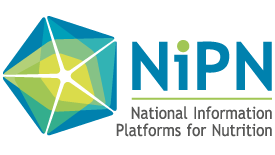Characteristics of the NIPN Dashboard (3/4)
3. Clear, easy to read and understand
Users often have limited time. Therefore, the dashboard needs to be short (4-6 pages), simple and clear so that reading through the main messages will only take a few minutes.
The target users of the dashboards are not necessarily data experts nor used to complex graphs and messages. This needs to be taken into account when presenting data:
- Bar charts are usually well understood (see example below)
- Confidence intervals are rarely fully understood
- Complex charts are less easy to understand (see example below)
- Common language must be used to explain the meaning of the indicators, with as little technical or scientific jargon as possible

Simple bar chart from the POSHAN initiative (left) and complex representation from the Global Nutrition Report (right)
4. “Tells the story”, with questions to stimulate discussion and reflection
The dashboard needs to clearly guide the user in a logical flow of information:
- The different areas of the causal framework of nutrition (Lancet, 2013) are used (“Immediate causes”, “Underlying causes”, “Nutrition-specific interventions”, etc.) as a basis for organising the dashboard.
- The impact pathway logic has been adopted in the dashboard and is explained in the introduction to the NIPN approach. This is used to “tell the story” and spell out the link between inputs (e.g. financial and human resources) which are invested in activities (programmes and interventions) to influence the determinants of nutrition (immediate, underlying, basic) and result in a positive impact on nutrition indicators.
- The messages conveyed in the dashboard can be strengthened through discussion or presentation, especially with non-nutrition specialists.
- In order to initiate dialogue with policy makers, it is crucial to identify key discussion points which emerge logically from the data presented. Examples of questions have been inserted in the dashboard, but can be modified to reflect the national nutrition priorities identified in the multisectoral plan of action for nutrition.
- How can the district increase rates of woman literacy and reduce early marriage?
- How does the district perform on providing drinking water and sanitation to its residents? Since sanitation and hygiene play an important role in improving nutrition outcomes, how can all aspects of sanitation be improved?
- How does the district fare on food security?


